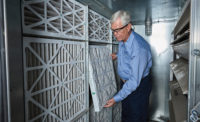Budgeting for planned mechanical system repairs is always preferred over waiting for a catastrophic event to occur and then draining the “emergency fund” budget to pay for it. Life use of the equipment is extended when periodic inspections of the mechanical systems identify and address small problems, increasing the property value and providing a better return on the initial investment.
The second benefit has to do with indoor air quality. Poorly maintained mechanical systems are a breeding ground for airborne contaminants. Providing regularly scheduled maintenance on the mechanical systems will reduce objectionable odors, and discourage the formation of algae, mold, and bacterial growth. A clean building is a healthy building.
This article details the procedure for a preventive maintenance program for vertical packaged terminal air conditioners (ptac’s).
Scheduled preventive maintenance inspections (PMIs) should be performed four times a year. At the beginning of the cooling season, a complete mechanical cooling check should be performed.
Periodic minor inspections may be necessary during the cooling season to adjust for variations in climate. At the beginning of the heating season, a complete mechanical heating check should be performed. Again, periodic minor inspections may be necessary to adjust for climatic changes.
Cooling Season
Note: Disconnect the power!Are there any unusual odors? This could indicate burned motor windings. Are there any leaks (water, refrigerant)? Is the drain pan clean?
Ask the tenant, homeowner, or user if they have noticed anything unusual with the equipment, such as unusual sounds.
Also, look for oil leaks or stains on or around the coil and refrigerant lines. The presence of oil here indicates a potentially serious problem (refrigerant leak).
At this time, check the seal around the unit. Air leaks may make the conditioned area uncomfortably drafty or produce noises. Visually inspect the foam gasket between the wall and the unit; especially take note of the separation between the air inlet for the condenser and the condenser coil discharge. These two areas must be sealed off from each other.
If you experience poor cooling operation or erratic operation, check for air recirculation at the condenser coil.
Coy is the technical service manager for Enviromaster International LLC (EMI), Rome, NY, www.enviromaster.com (website).
Publication date: 06/11/2001






